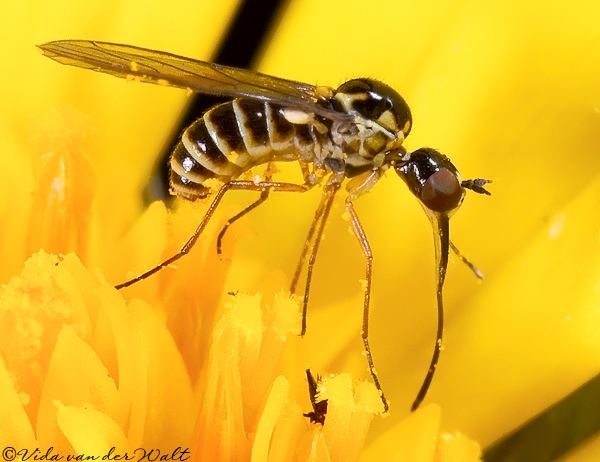Rank Family | Higher classification Asiloidea Order Fly | |
 | ||
Similar Chyromyidae, Apsilocephalidae, Hilarimorphidae, Megamerinidae, Fly | ||
The family Mythicomyiidae, commonly called mythicomyiids, are very tiny flies (0.5–5.0 mm) found throughout most parts of the world, especially desert and semidesert regions, except the highest altitudes and latitudes. They are not as common in the tropics, but genera such as Cephalodromia and Platypygus are known from these regions. Many of these "microbombyliids" have humpbacked thoraces and lack the dense vestiture common in the Bombyliidae. Mythicomyiids have until recently not had much attention in the literature. Their small size has caused them to be missed when collecting. Yellow pan trapping and fine-mesh netting in Malaise and aerial sweep nets has resulted in a tremendous amount of undescribed material from many parts of the world. A high amount of diversity of both genera and species exists for this family in Africa, especially northern and southern portions. About 350 species are known (most in the genus Mythicomyia Coquillett). Hundreds more await description.
Because of their extremely small size and curious body shapes, some genera have been at times placed in the Acroceridae or Empididae. Originally, taxa were placed in the subfamily Mythicomyiinae in the Empididae. Later, they were transferred to the Bombyliidae, where mythicomyiids have long been treated. Zaitzev (1991) was the first to give characters warranting raising the group to family level. Subsequent workers have followed Zaitzev's lead and treat the group as a separate family. The family is separated from the Bombyliidae by the unbranched wing vein R4+5 (branched in Bombyliidae), the extremely reduced or absent maxillary palpi (present in Bombyliidae), wings held together over the abdomen at rest (held at an angle in Bombyliidae), and the abdominal spiracles being placed in the terga (placed in the pleural membrane in Bombyliidae). Augmenting the morphological characters, it is also a much older lineage than any known Bombyliidae, dating from as far back as the Middle Jurassic (Palaeoplatypygus Kovalev; Callovian: 163–168 mya) with other genera known from the Cretaceous (Procyrtosia Hennig and Proplatypygus Zaitzev). Bombyliidae, though, are not known from any older fossil material than Eocene Baltic amber deposits (Lutetian to Rupelian: 30–52 million years ago).
